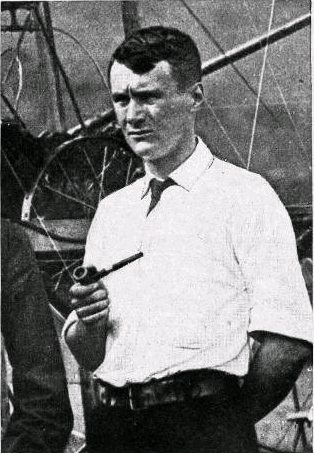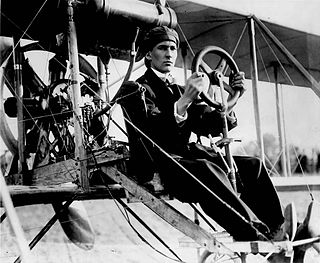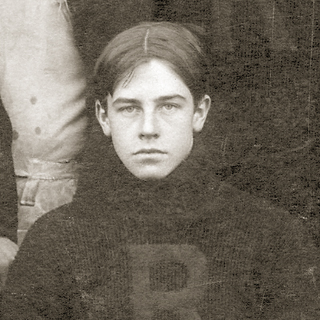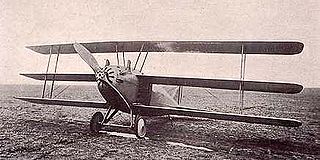
An aileron is a hinged flight control surface usually forming part of the trailing edge of each wing of a fixed-wing aircraft. Ailerons are used in pairs to control the aircraft in roll, which normally results in a change in flight path due to the tilting of the lift vector. Movement around this axis is called 'rolling' or 'banking'.

Thomas Etholen Selfridge was an American first lieutenant in the U.S. Army and the first person to die in an airplane crash. He was also the first active-duty member of the U.S. military to die in a crash while on duty. He was killed while seated as a passenger in a Wright Flyer, on a demonstration flight piloted by Orville Wright.

The Aerial Experiment Association (AEA) was a Canadian-American aeronautical research group formed on 30 September 1907, under the leadership of Dr. Alexander Graham Bell.
This is a list of aviation-related events from 1908:

The Curtiss-Wright XP-55 Ascender is a 1940s United States prototype fighter aircraft built by Curtiss-Wright. Along with the Vultee XP-54 and Northrop XP-56, it resulted from United States Army Air Corps proposal R-40C issued on 27 November 1939 for aircraft with improved performance, armament, and pilot visibility over existing fighters; it specifically allowed for unconventional aircraft designs. An unusual design for its time, it had a canard configuration with a rear-mounted engine, and two vertical tails at end of swept wings. Because of its pusher design, it was satirically referred to as the "Ass-ender". Like the XP-54, the Ascender was designed for the 1,800 hp Pratt & Whitney X-1800 24-Cylinder H-engine, but was redesigned after that engine project was canceled. It was also the first Curtiss fighter aircraft to use tricycle landing gear.

The Red Wing was an early aircraft designed by Thomas Selfridge and built by the Aerial Experiment Association in 1908. It was named for the bright red color of its silk wings — chosen to achieve the best result with the photographic materials and techniques of the day.

The June Bug was an American "pioneer era" biplane built by the Aerial Experiment Association (A.E.A) in 1908 and flown by Glenn Hammond Curtiss. The aircraft was the first American airplane to fly at least 1 km in front of a crowd.

The Cygnet was an extremely unorthodox early Canadian aircraft, with a wall-like "wing" made up of 3,393 tetrahedral cells. It was a powered version of the Cygnet tetrahedral kite designed by Dr Alexander Graham Bell in 1907 and built by the newly founded Aerial Experiment Association.
The 1911 Curtiss Model D is an early United States pusher aircraft with the engine and propeller behind the pilot's seat. It was among the first aircraft in the world to be built in any quantity, during an era of trial-and-error development and equally important parallel technical development in internal combustion engine technologies.

The Aeronautical Division, Signal Corps (1907–1914) was the first heavier-than-air military aviation organization in history and the progenitor of the United States Air Force. A component of the U.S. Army Signal Corps, the Aeronautical Division procured the first powered military aircraft in 1909, created schools to train its aviators, and initiated a rating system for pilot qualifications. It organized and deployed the first permanent American aviation unit, the 1st Aero Squadron, in 1913. The Aeronautical Division trained 51 officers and 2 enlisted men as pilots, and incurred 13 fatalities in air crashes. During this period, the Aeronautical Division had 29 factory-built aircraft in its inventory, built a 30th from spare parts, and leased a civilian airplane for a short period in 1911.

Frederick Walker Baldwin, also known as Casey Baldwin, paternal grandson of Canadian reform leader Robert Baldwin, was a hydrofoil and aviation pioneer and partner of the famous inventor Alexander Graham Bell. He was manager of Graham Bell Laboratories from 1909–32, and represented Victoria in the Nova Scotia Legislature from 1933–37, where he was instrumental in bringing about the creation of Cape Breton Highlands National Park. In 1908, he became the first Canadian and British subject to fly an airplane.

The Curtiss Model N is a military trainer used primarily by the United States Navy during World War I.

The Boeing GA-1 was an armored triplane. Designed in 1919, it was powered by a pair of modified Liberty engines driving pusher propellers. The first of the Engineering Division's heavily armored GAX series aircraft, the ponderous airplane was intended to strafe ground troops while remaining immune to attack from the ground as well as from other enemy aircraft. Its armor resulted in an excessive five-ton weight.

The Douglas O-31 was the Douglas Aircraft Company's first monoplane observation straight-wing aircraft used by the United States Army Air Corps.

The Curtiss 18T, unofficially known as the Wasp and by the United States Navy as the Kirkham, was an early American triplane fighter aircraft designed by Curtiss for the US Navy.

The Curtiss Models F made up a family of early flying boats developed in the United States in the years leading up to World War I. Widely produced, Model Fs saw service with the United States Navy under the designations C-2 through C-5, later reclassified to AB-2 through AB-5. Several examples were exported to Russia, and the type was built under license in Italy.

The Curtiss Model E is an early aircraft developed by Glenn Curtiss in the United States in 1911.

The Curtiss No. 2, often known as the Reims Racer, was a racing aircraft built in the United States by Glenn Curtiss in 1909 to contest the Gordon Bennett Cup air race in Reims, France that year.

The Orenco D was an American biplane fighter aircraft, designed by Orenco and built by Curtiss Aeroplane and Motor Company. It was the first fighter type of completely indigenous design to enter US military service.

The Waco 10/GXE/Waco O series was a range of three-seat open-cockpit biplanes built by the Advance Aircraft Company, later the Waco Aircraft Company.


















